DURABOOK S14I
Durabook Americas' remarkably slim and light semi-rugged laptop boasts impressive design and connectivity, and superior 11th gen Intel Core power
(by Conrad H. Blickenstorfer; photography by Carol Cotton)
Share on:



When Durabook Americas initially launched its DURABOOK S14I heavy-duty laptop, the company called it the "most durable semi-rugged computer available." The S14I exceeded the ruggedness standards of "semi-rugged" laptops, a class of notebook computers positioned between regular, unprotected laptops and "fully" rugged versions that are big and expensive. With the S14I, Durabook took on the leaders in that "semi-rugged" class, the Getac S410, Panasonic Toughbook 55, and the Dell Latitude Rugged, all aiming at customers who need more durability and ruggedness than standard consumer notebooks can provide.
Now Durabook is doubling down on its commitment with an updated version of the S14I, one that serves notice to the "Big Three" that Durabook is here to stay and they better watch out. Because this time Durabook isn't only raising the standard in ruggedness, it raises the standard in performance as well.
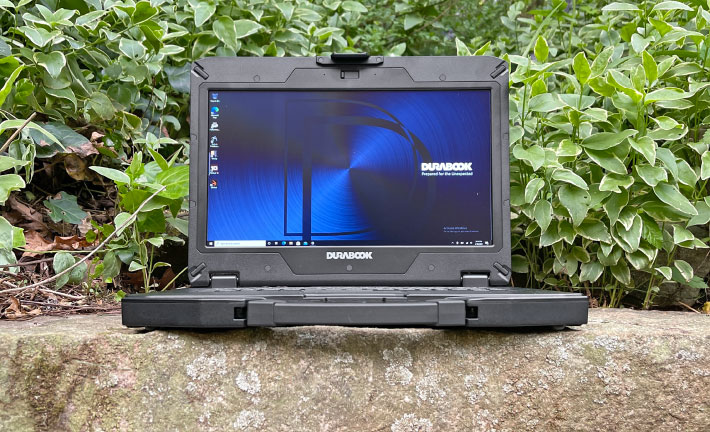
Durabook Americas, the North American subsidiary of Twinhead International has been in this market for well over decades, specializing in laptops and tablets tough enough for a wide range of applications and environments, but generally costing less than half as much as "fully-rugged" products. Over the past few years, Durabook has been moving upmarket both in terms of ruggedness and performance.
As of Spring 2021, Durabook offers a quartet of toughened-up laptops, those being the 14-inch S14I and 15.6-inch S15AB on the semi-rugged side, and the 13.3-inch R8300 and 14-inch Z14I on the fully rugged side. In terms of positioning, the S15AB appeals to customers seeking a big-screen laptop that's technologically up-to-date (Intel 8th gen Core processors) and doesn't weigh a ton. The Z14I is a no-holds-barred fully rugged machine also currently at the 8th generation of Core processors. The R8300 is a legacy machine (now powered by 7th gen Core processors) kept in production largely as an updated replacement for a considerable number of aging General Dynamics Itronix machines that were OEMed by Twinhead.
For now, the star of the lineup is clearly the S14I. With many enterprise, government and other public service customers interested in laptops that are tough enough for the job but also lighter, handier and more technologically up-to-date than the traditional fully rugged machines, the fast moving semi-rugged laptop market is increasingly attractive. And with its latest updates and enhancements, the DURABOOK S14I is now a serious contender. Tom Wang, Durabook Americas' president, said, "our refreshed S14I laptop takes semi-rugged devices to a whole new level. It is the perfect mobile device for today's demanding and diverse working environments."
The DURABOOK S14I — overview
The DURABOOK S14I is a full-size notebook with a 14.0-inch wide-format screen. It measures 13.8 x 11.1 (including the handle) x 1.5 inches and, minimally equipped, weighs just over five pounds. That's thicker and heavier than a standard consumer notebook, but remarkably light and compact by rugged notebook standards. While earlier DURABOOKS often had a kind of generic look to them, the S14I an elegant, impressive design that instantly conveys toughness, quality and purpose.
|
DURABOOK S14I original vs new
|
|
|
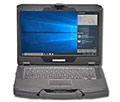
|

|
|
DURABOOK model
|
S14I (2018)
|
S14I (2021)
|
|
Weight
|
5.1 lb
|
5.1 lb
|
|
Intel Processor
|
8th generation
|
11th generation
|
|
Graphics
|
Intel UHD
|
Iris Xe or Intel UHD
|
|
Discrete Graphics
|
opt. Nvidia GTX 1050
|
opt. Nvidia GTX 1050
|
|
Standard Storage
|
Hard disk
|
PCIe NVMe SSD
|
|
Optional Storage
|
SATA SSD
|
2 x SATA SSD
|
|
Max Battery capacity
|
2 x 51 watt-hours
|
2 x 51 watt-hours
|
|
USB Type-A
|
2 x USB 3.1, 2 x USB 2.0
|
3 x USB 3.2, 1 x USB 2.0
|
|
USB Type-C
|
No
|
Yes (supports DP)
|
|
Drop spec
|
4 feet
|
4 feet
|
|
Sealing
|
IP53
|
IP53
|
|
Starting price
|
US$1,399
|
US$1,399
|
All the conveniences and features of a consumer notebook are there: a clean, logical full-size keyboard, up to a terabyte of super-fast PCIe NVMe solid state disk and available secondary and even tertiary SATA III solid state storage modules, room for a Super Multi DVD drive if so desired, a wealth of card reader options (ExpressCard, PC Card, SDXC Card, Smart Card, SIM), enough memory (up to 64GB of state-of-the-art DDR4), and plenty of onboard connectivity both wired and wireless.
Durabook Americas has always been progressive in making available to their customers the latest Intel processors. This time again they are at the very forefront: the DURABOOK S14I comes with the choice of one of five Intel 11th generation "Tiger Lake" Core i3, i5 and i7 CPUs. Our review unit was equipped with the line's next-to-highest end Core i7-1165G7 quad-core vPro processor.
The DURABOOK S14I features magnesium-alloy for chassis and part of the exterior, very solid display hinges, and a fully integrated carry-handle. It feels way more solid than any consumer laptop. All ports and slots are behind protective doors.
Note, however, that this is not a fully sealed machine. It can handle spills and rain but, unlike in fully-rugged designs, there are ventilation slots and other unsealed openings. That's what semi-rugged means, a good deal of protection for most use scenarios, but not the total immunity to the elements that fully-rugged systems offer.
Design, look, and feel
The product photography compilation below shows the DURABOOK S14I from the top and all four sides. It's an undeniably attractive design that looks even better in person. The strong magnesium alloy chassis and bottom mean the computer doesn't creak and twist like most plastic consumer laptops. The body of the S14I is black, the top of the LCD case is a dark matte silver-gray with a powder-coat finish, black accents, and a designated logo area (Durabook Americas machines often sell in rebadged versions). The top of the LCD case is contoured to add extra stiffness.
The DURABOOK S14I perfectly projects the tough tool-for-the-job look common to most current semi- and fully rugged notebooks. The heavy-duty LCD hinges offer good resistance when opening and closing the computer. When closing the laptop, a spring-loaded latch snaps into place, securing the LCD when in closed position. To open the notebook again, you push a spring-loaded lock.
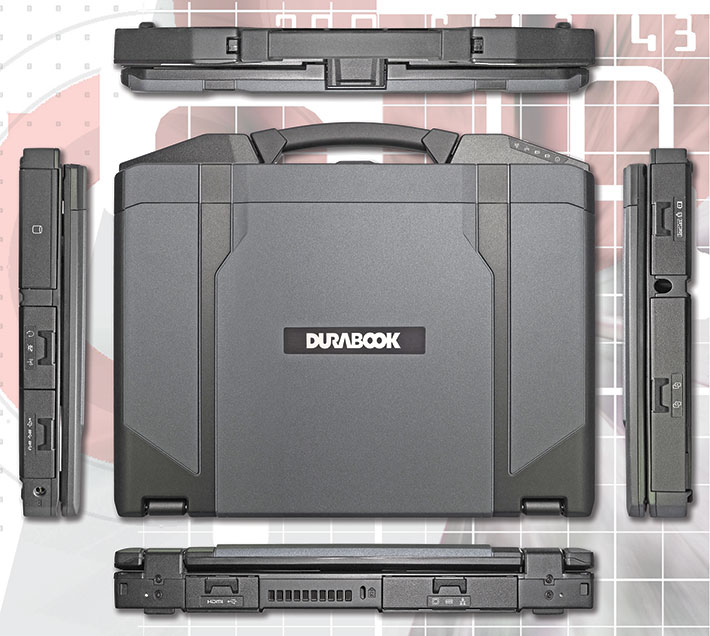
Ports and connectivity are placed on the left, right and back side of the computer. The ports on each side are located behind hinged plastic covers that protect against physical damage and also provide a good degree of protection against dust and liquids. All covers are screwed on and easily replaceable.
The two pictures below show a more detailed view of the left and right side of the DURABOOK S14I.
On the left side (top picture), from left to right, you can see the two card slots (in our a unit a PC Card Type II and an ExpressCard slot), a garage for the supplied passive stylus, and then the battery garage with a SmartCard reader on top.

On the right side, from left to right, are the quick-release mass storage compartment, then an audio jack, an SD Card reader, an airplane mode switch, a Type-A USB 2.0 port, two Type-A USB 3.2 Gen 2 ports that support communication rates up to 10 Gbp, and then the power jack.
In the back of the machine, again from left to right, is a standard Type-A HDMI port, a reversible Type-C USB 3.2 Gen 2 port that also supports DisplayPort, then the fan's heat exchanger, a Kensington lock slot, a D-sub 15-pin VGA port, a legacy DB9 RS232/RS422/RS485 serial port, and an RJ45 LAN jack.

Below you can see how the DURABOOK S14I provides easy access to its interior via a large removable bottom plate that is held in place by just three small screws. Once removed, you can see what sits underneath: storage, RAM, WWAN, WLAN, GPS, CPU, and room for an optional small bridge battery. All modules are easily recognizable and easily replaceable. Note that the cover has a couple of ventilation slots where liquids can get in. Remember, this is a spill-resistant laptop, but not a fully sealed one.
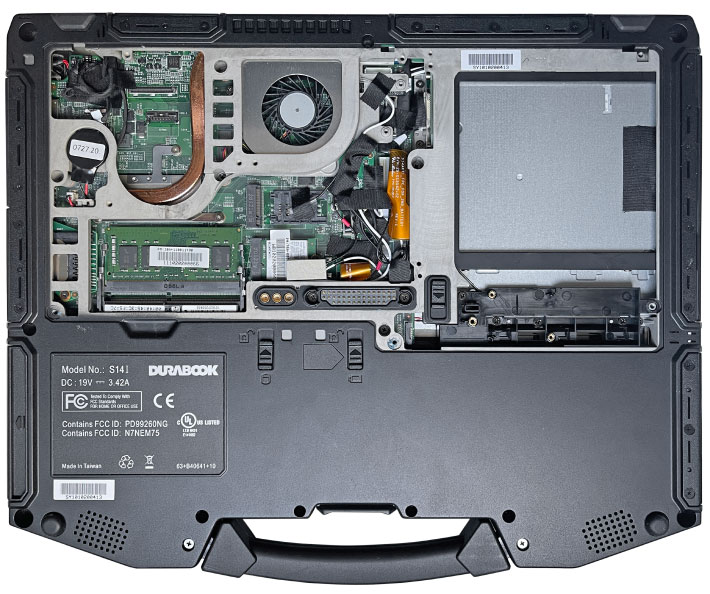
Once the cover is removed, you can also see the copper heat tubing that syphons heat away from the processor to the heat exchanger/fan assembly. Good thermal management is crucial in notebooks designed to be used in a variety of operating temperatures, even with today's much more efficient and cooler-running processors. And this goes double for machines equipped with Intel 11th generation Core processors that add complexity by giving manufacturers much more leeway on the thermal characteristics of processors.
While this type of active, fan-assisted thermal management system was initially designed for older and much more power-hungry standard voltage processors (earlier DURABOOKs often had 35 watt processors instead of Intel's latest and much more efficient mobile chips), fans and elaborate cooling systems may well assume central importance again with Intel's latest changes that we'll shorty get into. Fans can be a pain when they are loud and come on often. Fortunately, the fan in the S14I isn't one of them. It doesn't come on often, is quiet despite its variable speed, and helps to keep the machine cool and all those sensors that continuously monitor temperature happy. That does not only prolong life, but also makes for optimized peak performance.
We wish that the switch to ever more efficient processors will eventually alleviate the need for mechanical fans, eliminating both noise, dust accumulation, and the extra openings in the case for air to go in and out. But that time isn't here just yet. In fact, getting thermal design just right is more important than ever.
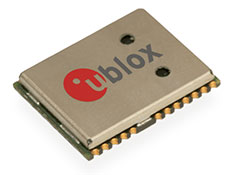 Above the fan are two SODIMM RAM slots. Our review machine came with one 16GB Kingston stick. Next to the RAM connectors are a couple of PCIe M.2 sockets for expansion. One is used for WiFi (Intel Wi-Fi 6 AX201 802.11a/b/g/n/ac/ax with Bluetooth 5.1 in our unit), the other for optional WWAN. Both have prewired antenna leads. Next to one of the sockets, underneath an installed module card, is a SIM card slot.
Above the fan are two SODIMM RAM slots. Our review machine came with one 16GB Kingston stick. Next to the RAM connectors are a couple of PCIe M.2 sockets for expansion. One is used for WiFi (Intel Wi-Fi 6 AX201 802.11a/b/g/n/ac/ax with Bluetooth 5.1 in our unit), the other for optional WWAN. Both have prewired antenna leads. Next to one of the sockets, underneath an installed module card, is a SIM card slot.
Our review unit also came with a ublox NEO-M8N concurrent GNSS module. A great feature of the M8N is that it can track up to three of the four available GNSS systems concurrently, those being GPS (the US system), GLONASS (the Russian version of GPS), the European Galileo, and the Chinese BeiDou. The ability to track three of those systems means potentially triple the number of available satellites, making for quick starts, very good accuracy, and superior coverage.
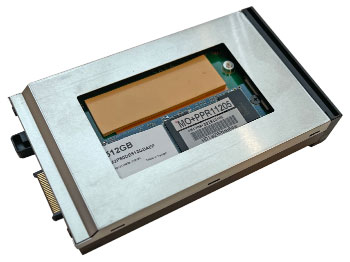 The solid state drive is located inside a black plastic box with a metal cover that fits flush into the recessed compartment on the upper left. Fortunately, old-fashioned, crash-prone hard drives are gone from all newer rugged devices and that, of course, also goes for the S14I. The caddy can accommodate one or two speedy NVME PCIE solid state disks. 256GB is standard, ours came with 512GB. Optionally available are self-encrypting OPAL 2.0 SSDs.
The solid state drive is located inside a black plastic box with a metal cover that fits flush into the recessed compartment on the upper left. Fortunately, old-fashioned, crash-prone hard drives are gone from all newer rugged devices and that, of course, also goes for the S14I. The caddy can accommodate one or two speedy NVME PCIE solid state disks. 256GB is standard, ours came with 512GB. Optionally available are self-encrypting OPAL 2.0 SSDs.
As is, the mass storage caddy is designed to quickly be removed from the laptop. That is often a requirement in enterprise and government settings. The caddy is locked and unlocked via a friction lever. It is not likely to come lose unintentionally.
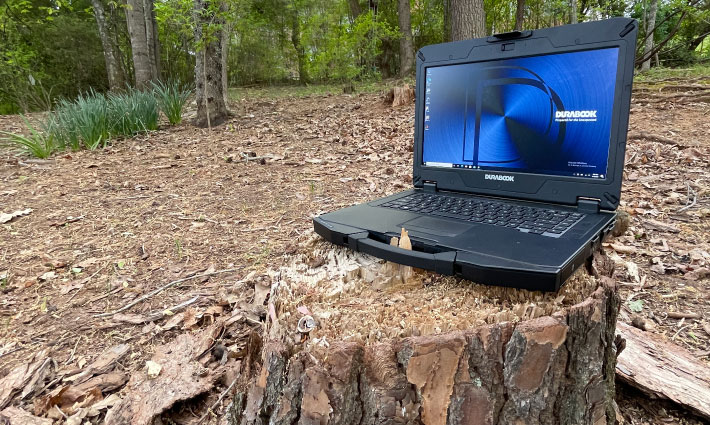
We didn't dismantle the S14I further as the removable bottom cover is gratifyingly large and allows very easy access to all relevant electronics. What is notable here is the magnesium alloy chassis of the S14I that actually forms the entire bottom part of the laptop. It's a thing of beauty and quite obviously forms a very strong structural foundation for the device.
Keyboard and touch pad — pleasant
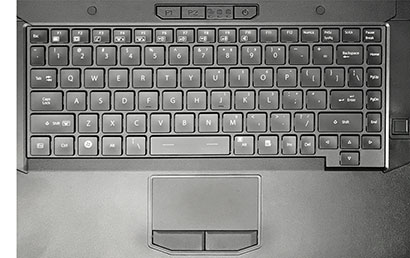 The DURABOOK S14I's keyboard is full-scale and has 88 keys. The key design is standard "island" style with flat keys and minimal travel but good tactile feedback, as is common in today's notebooks and even desktop keyboards.
The DURABOOK S14I's keyboard is full-scale and has 88 keys. The key design is standard "island" style with flat keys and minimal travel but good tactile feedback, as is common in today's notebooks and even desktop keyboards.
The central QWERTY layout is 100%-scale, which means the distance between the center of the Q key on the left and the P key on the right is 6.75 inches. That makes it perfect for touch typists. The keys are black with white letters, numbers and symbols. Optionally available is an LED keyboard backlight with brightness adjusted via function keys.
Below the keyboard is the unit's capacitive touch pad. It is a now properly sized (35% larger than in the predecessor version) touch area with a slight frame around it so your fingers feel the extent of the pad, and with two large mouse buttons in front of it. The mouse buttons require a relatively firm press and issue an audible mechanical click. The touch pad is very responsive and easy to use, and it can even be operated with gloves on (as long as they are not too thick).
Above the keyboard are two programmable function buttons, three status indicator lights (disk activity, numlock, capslock), and then power/sleep button.
11th generation Core processors
When Durabook initially designed the S14I they didn't only make it thinner, lighter, tougher and technologically more advanced than its semi-rugged predecessors, they also made it a strong competitor in the overall global market for semi-rugged laptops. Competitiveness, of course, is a moving target and remaining competitive is never more than a competitor's upgrade or new model away.
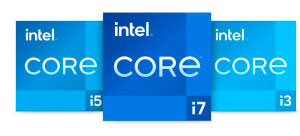 As of this writing (late April 2021), of the semi-rugged laptop competition, the Panasonic Toughbook 55 and Dell's Latitude 5420/5424 are still at the 8th generation of Intel Core processors. The DURABOOK S14I and the latest generation of the Getac S410, on the other hand, are built around Intel's 11th generation of Core processors. Intel's 12th generation — Alder Lake — will be here soon enough, but for now 11th gen "Tiger Lake" is it.
As of this writing (late April 2021), of the semi-rugged laptop competition, the Panasonic Toughbook 55 and Dell's Latitude 5420/5424 are still at the 8th generation of Intel Core processors. The DURABOOK S14I and the latest generation of the Getac S410, on the other hand, are built around Intel's 11th generation of Core processors. Intel's 12th generation — Alder Lake — will be here soon enough, but for now 11th gen "Tiger Lake" is it.
On the surface, there haven't been drastic changes in the last few generations of Intel's Core processors. Efforts to continue making gates — the basic building blocks of computer chips — smaller and smaller have proven to be difficult and time-consuming. As a result, Intel has primarily been fine-tuning and optimizing to eke out improvements in efficiency and performance. In fairness, there have been some milestones. One was making quad-core chips available in the "Coffee Lake" 8th generation. And now we may be seeing another in the "Tiger Lake" 11th generation used in the DURABOOK S14I.
Before we get into that, here's a list of all the processor options available for the DURABOOK S14I (to view the full Intel spec table for these five CPUs, see here):
|
DURABOOK S14I: Processor options
|
|
PROCESSOR OPTIONS
|
Core i7
|
Core i7
|
Core i5
|
Core i5
|
Core i3
|
|
Model
|
1185G7
|
1165G7
|
1145G7
|
1135G7
|
1115G4
|
|
Gen
|
11th
|
11th
|
11th
|
11th
|
11th
|
|
Cores/Threads
|
4/8
|
4/8
|
4/8
|
4/8
|
2/4
|
|
Max Turbo Speed
|
4.80 GHz
|
4.70 GHz
|
4.40 GHz
|
4.20 GHz
|
4.10 GHz
|
|
Cache
|
12MB SmartCache
|
12MB SmartCache
|
8MB SmartCache
|
8MB SmartCache
|
6MB SmartCache
|
|
TDP-up
|
28 watts, 3.00GHz
|
28 watts, 2.80GHz
|
28 watts, 2.60GHz
|
28 watts, 2.40GHz
|
28 watts, 3.00GHz
|
|
TDP-down
|
12 watts, 1.20GHz
|
12 watts, 1.20GHz
|
12 watts, 1.10GHz
|
12 watts, 0.90GHz
|
12 watts, 1.70GHz
|
|
Graphics
|
Intel Iris Xe
|
Intel Iris Xe
|
Intel Iris Xe
|
Intel Iris Xe
|
Intel UHD
|
|
Graphics max speed
|
1.35 GHz
|
1.35 GHz
|
1.30 GHz
|
1.30 GHz
|
1.25 GHz
|
|
Graphics Execution Units
|
96
|
96
|
80
|
80
|
48
|
|
Intel vPro
|
Yes
|
No
|
Yes
|
No
|
No
|
|
Intel TME
|
Yes
|
No
|
Yes
|
No
|
No
|
|
Intel SIPP
|
Yes
|
No
|
Yes
|
No
|
No
|
|
Intel Trusted Execution
|
Yes
|
No
|
Yes
|
No
|
No
|
|
Relative cost
|
1.52
|
1.52
|
1.10
|
1.10
|
1.00
|
The top processor option for the DURABOOK S14I is the Intel Core i7-1185G7. This high-end chip offers the highest maximum turbo frequency as well as the highest frequencies at the 28 watt and 12 watt TDP-Up and TDP-down settings. Next in line is the Core i7-1165G7 (installed in our review unit). It is a bit slower overall and doesn't include some of Intel's special technologies. Next are two Core i5 chips that have only 8MB instead of 12MB SmartCache, fewer graphics execution units, as well as small clock frequency and included Intel technology differences. The low-end i3-1115G4 chip is the only one with just two cores instead of four, and also the only one without Intel's more powerful new Iris Xe graphics.
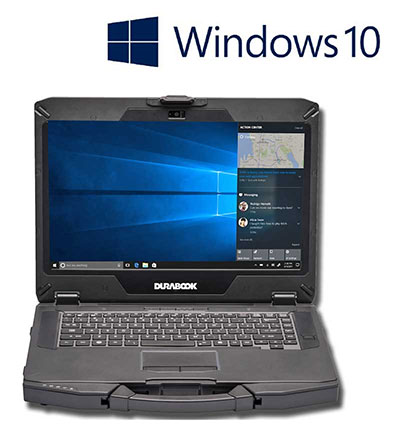 What may make a difference in certain applications is the availability of four special Intel technologies (vPro, TME, SIPP, and Trusted Execution) included in the i7-1185G7 and i5-1145G7, but not in the other three processors. Here's what that means:
What may make a difference in certain applications is the availability of four special Intel technologies (vPro, TME, SIPP, and Trusted Execution) included in the i7-1185G7 and i5-1145G7, but not in the other three processors. Here's what that means:
- The extra security and manageability capabilities of vPro, especially, are required in many enterprise deployments.
- TME (Total Memory Encryption) ensures that all memory accessed from the CPU is encrypted, including customer credentials, encryption keys, and other IP or personal information on the external memory bus.
- SIPP (Stable Image Platform Program) allows deployment of standardized, stable image PC platforms for at least 15 months, and
- Trusted Execution technology provides security capabilities such as measured launch and protected execution, and may thus also be an enterprise requirement.
To see what kind of performance the new quad-core DURABOOK S14I can achieve, we ran our standard benchmark suites, Passmark Software's PerformanceTest 6.1 and 9.0 that include dozens of tests covering CPU, 2D graphics, 3D graphics, memory, and disk and then computes scores for each category and an overall PassMark scores. We also ran our second benchmark suite, CrystalMark, to provide some clues as to overall single core performance.
To provide an idea where the new DURABOOK S14I stands in terms of overall performance, the below table also includes results of the prior generation DURABOOK S14I as well as some of the new S14I's prominent semi-rugged and fully-rugged competition.
The results are as follows:
|
DURABOOK S14I Benchmarks and Comparisons
|
|
|
DURABOOK
|
DURABOOK
|
Dell
|
DT Research
|
Getac
|
Panasonic
|
|
Model
|
S14I
|
S14I
|
Latitude 5420
|
LT330
|
B360 PRO
|
Toughbook 55
|
|
Year tested
|
2021
|
2019
|
2018
|
2021
|
2021
|
2019
|
|
Processor Type: Intel
|
Core i7
|
Core i5
|
Core i7
|
Core i7
|
Core i7
|
Core i5
|
|
Processor Model
|
1165G7
|
8250U
|
8650U
|
10710U
|
10710U
|
8365U
|
|
Generation/Code name
|
11 - Tiger Lake
|
8 - Kaby Lake R
|
8 - Kaby Lake R
|
10 - Comet Lake
|
10 - Comet Lake
|
8 - Whiskey Lake
|
|
CPU Speed
|
2.80 GHz
|
1.60 GHz
|
1.90 GHz
|
1.10 GHz
|
1.10 GHz
|
1.60 GHz
|
|
Turbo Speed
|
4.70 GHz
|
3.40 GHz
|
4.20 GHz
|
4.70 GHz
|
4.70 GHz
|
4.10 GHz
|
|
Thermal Design Power (TDP)
|
12/28 watts
|
15 watts
|
15 watts
|
15 watts
|
15 watts
|
15 watts
|
|
CPU Mark 6.1
|
18,046.9
|
6,850.6
|
10,460.3
|
10,901.6
|
9,546.0
|
11,110.8
|
|
2D Graphics Mark 6.1
|
533.2
|
305.4
|
330.7
|
441.2
|
430.8
|
409.6
|
|
Memory Mark 6.1
|
3,776.0
|
1,843.3
|
2,653.8
|
2,508.1
|
4,879.3
|
1,973.9
|
|
Disk Mark 6.1
|
22,713.7
|
4,951.9
|
9,443.5
|
18,718.2
|
14,090.2
|
4,757.3
|
|
3D Graphics Mark 6.1
|
1,407.7
|
425.5
|
786.4
|
703.6
|
801.3
|
503.2
|
|
Overall PassMark 6.1
|
10,338.7
|
3,265.7
|
5,331.3
|
7,284.8
|
6,430.2
|
4,424.4
|
|
CPU Mark 9
|
10,398.6
|
6,839.9
|
9,178.2
|
9,933.6
|
9,788.7
|
8,959.2
|
|
2D Graphics Mark 9
|
962.9
|
498.7
|
726.0
|
720.9
|
675.7
|
686.7
|
|
Memory Mark 9
|
2,591.1
|
2,240.7
|
2,855.8
|
2,585.5
|
2,576.7
|
2,095.4
|
|
Disk Mark 9
|
15,390.6
|
4,736.3
|
11,023.5
|
24,611.5
|
21,116.1
|
5,214.8
|
|
3D Graphics Mark 9
|
2,821.6
|
872.7
|
1,245.1
|
1,194.6
|
3,026.3
|
1,049.5
|
|
Overall PassMark 9
|
5,164.5
|
2,726.5
|
3,906.9
|
3,948.8
|
4,531.8
|
3,325.6
|
|
CM ALU
|
109,766
|
59,613
|
80,465
|
85,483
|
65,656
|
89,917
|
|
CM FPU
|
58,997
|
53,477
|
57,003
|
55,266
|
46,729
|
67,200
|
|
CM MEM
|
141,396
|
49,102
|
73,208
|
83,159
|
84,390
|
59,177
|
|
CM HDD
|
96,715
|
43,671
|
63,955
|
69,970
|
75,184
|
43,198
|
|
CM GDI
|
26,107
|
14,814
|
17,920
|
20,440
|
18,310
|
17,930
|
|
CM D2D
|
7,105
|
4,580
|
6,806
|
6,293
|
7,492
|
5,931
|
|
CM OGL
|
15,570
|
8,544
|
13,273
|
16,002
|
35,296
|
13,481
|
|
Overall CrystalMark
|
455,646
|
233,801
|
312,630
|
336,613
|
333,057
|
296,834
|
What can we learn from these numbers? Well, the new DURABOOK S14I with the 11th generation Core processor is wicked fast! Way beyond what one would expect from the usually only marginal performance increases between Intel Core processor generations. Not only did the new DURABOOK S14I totally dominate its own predecessor in all benchmarks, it also dominated the overall comparison. Sure, the new S14I switched from SATA to much faster PCIe NVMe storage, but so has most of the competition. The answer must be in the 11th gen Core processor.
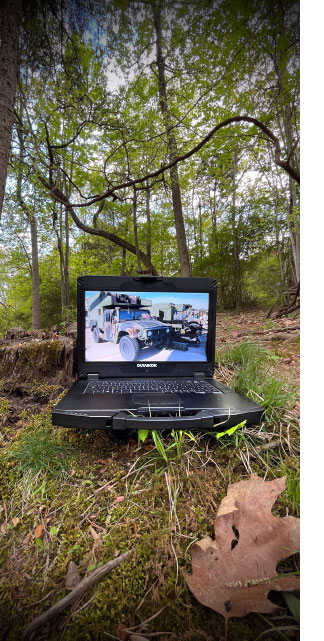 A look at Intel's 11th gen processor spec sheet shows an interesting change. Whereas earlier Core processor generations always showed the processor's base frequency and the maximum turbo frequency, 11th generation chips still show the maximum turbo frequency but no longer the default base frequency. Instead, the spec sheet shows the frequencies associated with "TDP-up" and "TDP-down." What does that mean?
A look at Intel's 11th gen processor spec sheet shows an interesting change. Whereas earlier Core processor generations always showed the processor's base frequency and the maximum turbo frequency, 11th generation chips still show the maximum turbo frequency but no longer the default base frequency. Instead, the spec sheet shows the frequencies associated with "TDP-up" and "TDP-down." What does that mean?
TDP stands for Thermal Design Power or Thermal Design Point. TDP is given in watts and indicates the maximum amount of heat generated by a processor that the computer's cooling system must be able to dissipate under a sustained full workload. The processor can go faster — as fast the maximum turbo frequency of the chip — but only for a very limited time, or else it would overheat.
TDP-up and TDP-down are configurable TDP options computer manufacturers (but not end users) may use instead of the default TDP. And that is where three additional variables come into play. Those aren't listed in spec sheets and are relevant only to manufacturer tech wizards that configure computers. The three that matter most are PL1, PL2 and Tau. PL1 — Power Level 1 — can be set as low as Intel's listed TDP-down power draw and associated frequency, and as high as Intel's stated TDP-up and associated frequency. PL2 — Power Level 2 — is higher than PL1, and can be as high as the chip's maximum turbo frequency. Tau is the maximum period of time the chip can run at full PL2 frequency until it must drop back down PL1 frequency (thermal sensors may mandate frequency reductions even before Tau time is used up).
Now it gets interesting. Prior to the 11th generation, Intel apparently favored predetermined TDP values. There was a base frequency and power management measures that switched up and down within the TDP range based on thermal and other variables. That resulted in greatly varying performance and battery life in different usage scenarios. For example, a machine might run much slower on a hot day outdoors than in the office.
Starting with the 11th generation, Intel is minimizing performance variation within power modes by allocating power dynamically within a set of PL1 and PL2 TDP values. Durabook's engineers took advantage of that and defined two power/performance modes they felt most aligned with the needs of their customers. In AC mode they set PL1 to the highest allowable value, 28 watts, and PL2 as high as their platform can handle. This is for all-out performance. In Battery mode, they set PL1 to the usual 15 watts and PL2 to the 28 watt maximum sustainable value. This results in an optimal balance between performance and battery life.
The graphs below illustrate how this difference between 10th and 11th generation can affect performance. Both the 11th gen DURABOOK S14I and a 10th gen-based test system were running 3DMARK's Time Spy benchmark. Now look at the purple curve that shows processor frequency during the heavy load benchmark: Both processors start out at high turbo frequency that then soon drops down to sustainable high load frequency. The 11th gen processor, however, keeps the frequency steady at the 28 watt PL1 value, whereas the 10th gen chip drops down to around 1GHz, corresponding to only just above its presumed 10 watt/800MHz PL1 value.
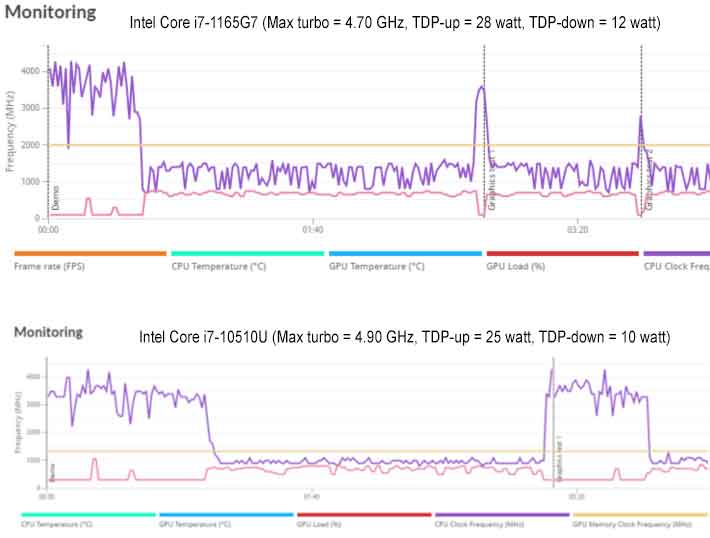
Now let's see what happens when the systems are on battery power. Here, the 11th gen system will try to stay as close to the PL1 limit of 15 watts for best performance while conserving power by dropping lower whenever it can. The 10th gen system hangs around 1GHz, much closer to its 800MHz TDP-down value than its stated 1.8GHz default frequency. Big difference.

Bottom line? Not easy to say. It's clear that the very high performance of the 11th gen system isn't all due to actual CPU improvements between 10th and 11th gen. It seems based more on Intel giving OEMs tools to set limits based on their customer requirements and the thermal capabilities of their platforms.
Does that make sense? That depends on how one looks at it. On the one hand, it makes selecting the optimal processor for a given task even more difficult and confusing than it already is. Why get an expensive i7 processor when a "tweaked" i3 chip may do the job as well or better for less money? On the other hand, truly optimizing processors not only for the job at hand, but also for the package they operate in makes sense. If a mobile device has plenty of thermal reserves, why not use that otherwise unused cooling capacity to get as much performance as a processor is truly capable of? The DURABOOK S14I does have that extra cooling capacity. We used our FLIR One Pro thermal camera to monitor heat levels of the S14I running strenuous benchmarks both in AC mode and in Battery mode and saw almost no difference; the laptop's thermal design could easily handle the extra heat generated. In both modes we saw a maximum of about 108F at the hottest surface point.
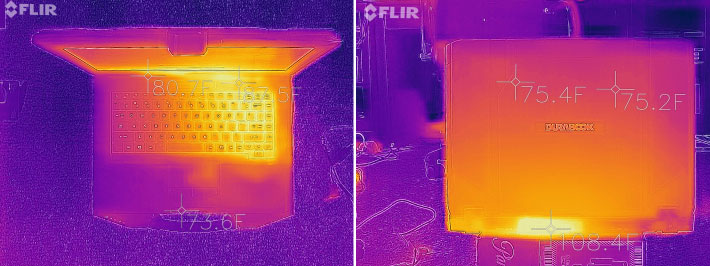
Another question comes up: how large is the performance difference between running the S14I in AC mode versus Battery mode? The table to the right shows the overall performance scores we recorded for a variety of benchmark tests in AC mode and in Battery mode, as well as the performance increase in percent AC mode has over Battery mode.
|
Durabook S14I Power mode performance comparisons
|
|
Power Mode
|
AC
|
Battery
|
AC > Battery %
|
|
PassMark 6.1
|
10,388.7
|
8,112.8
|
27.44%
|
|
PassMark 9.0
|
5,164.5
|
4,058.5
|
27.25%
|
|
PC Mark 10
|
4,570.0
|
3,457.0
|
32.20%
|
|
3DMark
|
1,040
|
825
|
26.06%
|
|
GeekBench 5
|
1,496
|
1,289
|
16.06%
|
|
CrystalMark
|
455,646
|
395,784
|
15.12%
|
|
Average AC > Battery
|
|
|
24.02%
|
Overall, we saw, depending on the benchmark test, performance increases between 15 and 32%, and an overall average increase of 24%. Given that in AC mode the S14I ran consistently at 2,800MHz and in Battery mode at a much lower 1,000 to 1,500MHz, the performance difference seems smaller than expected. That's because benchmark performance depends on more than just CPU clock speed. Memory, storage and graphics performance come into play as well.
In real life, a 24% difference is certainly noticeable, but it is not so large as to give the machine a whole different feel. What it does mean is this: in AC mode, the S14I will give every ounce of performance it can sustainably produce without overheating or slowing down. And in Battery mode it aims for an optimized, predictable balance between performance and battery life no matter what the field conditions are.
Why is this section so long? Because Intel's apparent decision to give OEMs more leeway in configuring processor performance under various conditions represents a big change. We're likely just seeing the beginning of a new era where high-end mobile computing device performance will be determined not just by the chosen processor, but by a combination of processor, thermal device design, and software/firmware tuning. DTT — Dynamic Tuning Technology — will play a large role in this, and it is only one part of a whole set of Intel software tools that help OEMs to tune a system for maximum performance by anticipating and optimally balancing frequencies and power draw against thermal constraints and load models.
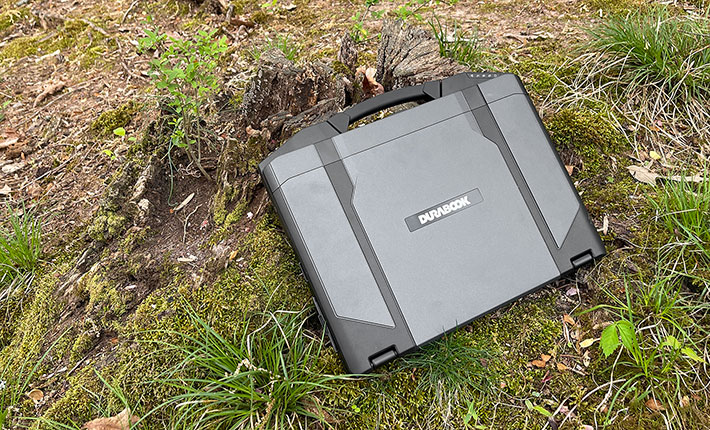
Power draw and battery life
It is one of the frustrations of modern life that mobile technology, the very tech that needs to be as small and light as possible, is also the tech that needs a battery, one that lasts as long as possible between charges. The bulk and weight of laptop batteries, especially, is a major detriment to true mobility, and sizing a laptop's battery is always an exercise in give and take. For the example, one of Durabook's older machines, the DURABOOK SA14, impressed with great battery life, but that came at the cost of a massive 87 watt-hour battery that weighed over a pound all by itself.
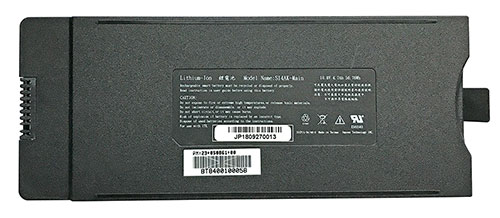 With the S14I, Durabook Americas picked up the trend of lighter, slimmer semi-ruggeds with a smaller standard battery but expansion space for an optional second battery.
With the S14I, Durabook Americas picked up the trend of lighter, slimmer semi-ruggeds with a smaller standard battery but expansion space for an optional second battery.
So instead of a massive default battery, the relatively thin and light S14I only gets 51 watt-hours, not much for such a powerful machine. If that's not enough, there's an optional second battery — also rated at the same 51 watt-hours — that goes into the expansion/media bay.
That doubles battery capacity to an impressive 102 watt-hours, but, of course, takes the space of other media bay options, such as an optical drive or expansion slots.
Is one of the new and smaller batteries enough for the high-performance DURABOOK S14I? Or do you realistically need the optional second battery? As is our standard procedure, we used Passmark Software's BatteryMon power management benchmark utility to measure the laptop's power draw under various operating conditions.
First we set the Windows 10 power options to "Max. Battery" and display brightness to its second to lowest setting (the lowest is total blackout). That way we saw an idle power draw of 5.5 watts. We then cranked the backlight up to 50%, and draw increased a bit to 6.3 watts. Then we cranked brightness all the way up to 100% and saw 8.6 watts.
|
Durabook S14I BatteryMon Power Draws (at idle)
|
|
Backlight level
|
Darkest
|
50%
|
Brightest
|
|
Max Battery
|
5.5 watts (9.2 hrs.)
|
6.3 watts (8.0 hrs.)
|
8.6 watts (5.9 hrs.)
|
|
Max Performance
|
5.8 watts (8.7 hrs.)
|
7.4 watts (6.8 hrs.)
|
14.3 watts (3.6 hrs.)
|
We then set the tablet to "Max Performance." At the lowest usable brightness setting we saw an idle power draw of 5.8 watts. At 50% brightness draw increased to 7.4 watts. And at the maximum standard brightness setting, electric draw reached 14.3 watts.
What do those power draw figures mean in terms of projected battery life? Equipped with just the standard battery, our review S14I had a battery capacity of 50.7 watt-hours. Dividing that by the 5.5 watt minimum observed draw would indicate 9.2 hours of theoretical battery life with the system staying awake the whole time. In the maximum performance settings and the very bright maximum brightness, theoretical battery life would drop to just 3.6 hours.
The power draws we observed demonstrate the importance of settings. Note the power draw difference at maximum brightness between the "Max Battery" and "Max Performance" setting. It's very large because when set to "Max Performance," the maximum brightness goes up to the very high brightness the S14I display can achieve. Under "Max Battery," even when set to maximum brightness, the brightness doesn't go up to nearly the same level. So keep that in mind.
What about using the S14I with both the standard and the secondary battery? Since both batteries are equally powerful, battery life would be doubled at the expensive of having other media bay options (like optical drive, 2nd storage, card slots, additional ports. The second battery only adds about 10 ounces of weight, so if the alternate media bay options are not needed, we'd go with the second battery.
Overall, realize that power draw is very relative. When plugged in, drawing more power to get the absolutely best possible performance is no problem, even if power draw is considerably higher. When on battery, power draw matters a lot and there's a constant compromise between performance, screen brightness, etc., and battery draw.
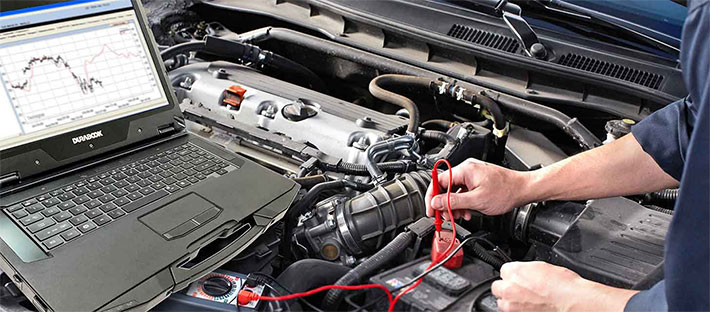
Display — very bright and great reflection control
The DURABOOK S14I's display measures 14 inches diagonal, which is standard for this type of laptop. Its 1920 x 1080 pixel resolution is better than the marginal 1366 x 768 that used to be the norm for semi-ruggeds. 1920 x 1080 makes for 157 pixels per inch, not great by smartphone or tablet standards but well matched for Windows 10 on a laptop of this size.  Brightness isn't given for the standard screen.
Brightness isn't given for the standard screen.
Our review unit came with the optional sunlight-viewable capacitive multi-touch display that has, per specs, a 1,000 nits luminance rating. There are stealth and night vision modes that may be required by some customers and agencies.
DURABOOK displays tend to look brighter than their nits ratings suggest, and the S14I's is no different. We used RuggedPCReview's new luminance testing equipment and our custom luminance chart to see how bright the S14I actually is. The test chart shows grayscale bands from 0% to 100% coverage in 25% increments.
As the image to the right shows, with a maximum recording of 1145 nits the S14I display easily outperformed its 1000 nits rating.
The screen isn't just bright and vibrant and easily suitable for all outdoor use; its surface is semi-matte, eliminating most of the reflection and glare common to today's consumer notebooks, and there seems to be a degree of anti-glare applied to it.
Both horizontal and vertical viewing angles are near perfect. There are, however, brightness and contrast shifts when looking at the screen from varying angles. Durabook offers the S14I with an optional capacitive multi-touch screen and our review unit was equipped with it. We don't consider touch a necessity on laptops, but almost everyone expects capacitive multi-touch these days. As is, touch on the S14I is as quick and effortless as on any modern tablet. One problem is that unlike tablets that have a smooth front, the S14I LCD is recessed by about 1/8th of an inch and there is no margin around the display. That means fingers often bump into the recessed border around the screen.
The picture below shows the S14I outdoors. The display backlight wasn't even set to full brightness. The screen looks bright, vibrant and perfectly readable.
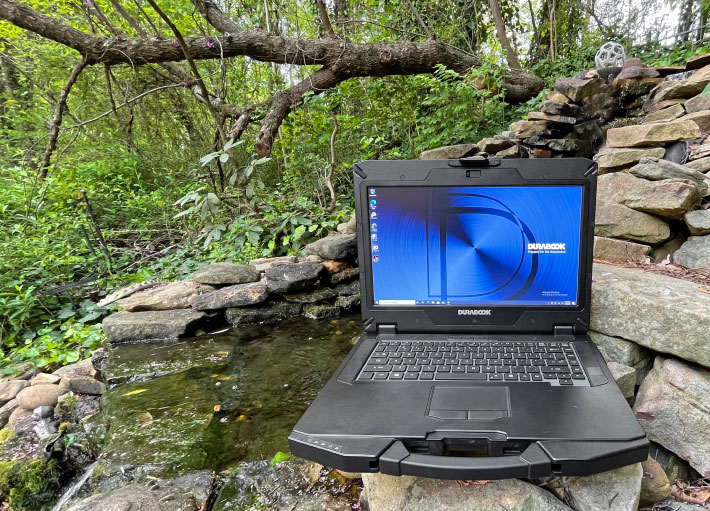
The images below shows a comparison between the DURABOOK S14I and a second-gen Apple iPad Pro 12.9-inch (which is said to reach about 600 nits) in bright daylight. The S14I was perceived as brighter head-on, so bright that it almost washed out the picture and we had to dial brightness down some. Looking at the displays from the left side, the S14I remained full-bright whereas the big iPad looked considerably dimmed.
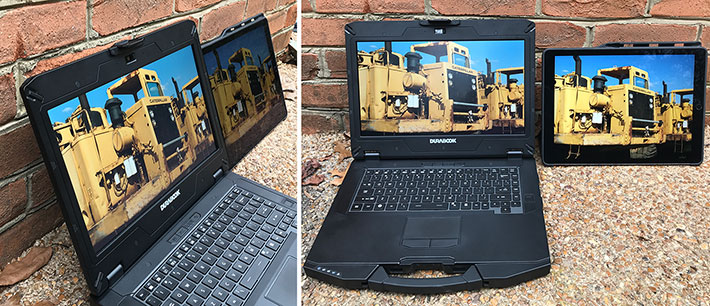
In the next picture we're looking at the DURABOOK S14I and the iPad Pro from above. Here, again, the S14I display doesn't lose any brightness whereas the iPad looks dimmed. Also, the DURABOOK's less glossy screen is unaffected by reflections whereas the iPad Pro display with its glossy screen showed strong reflections.

Overall, the DURABOOK S14I's display is very good. It is very bright and contrasty indoors, and it remains very readable even in strong sunlight. Unlike many earlier DURABOOK screens, the S14I's IPS display features wide viewing angles from all directions, a big plus. A caveat is that such a strong backlight quickly drains the battery if left on full bright.
Semi-rugged +
Durabook Americas' goals with the DURABOOK S14I are clear. One was to create a technologically advanced semi-rugged laptop that matched the competition in size and (light) weight. The other was to redefine what "semi-rugged" means. When the original S14I was launched in 2018 it leapfrogged the semi-rugged competition in several areas. That did not go unnoticed and most of the competition eventually followed suit.
While ruggedness metrics include a variety of tests, two stand out. What kind of a drop can a laptop survive? And how well is it protected against wetness and particulates. The former is measured in feet and testing is performed according to MIL-STD-810H procedures. The latter is expressed in an IP Ingress Protection) rating.
What Durabook Americas did with the original DURABOOK S14I was build it so it could handle 4-foot drops and get an IP53 rating.
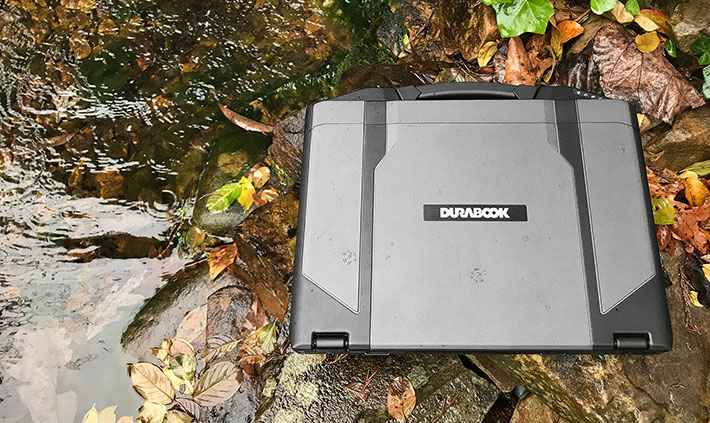
Why is this important? At the time it was a strategic advantage for Durabook and made the S14I suitable for some deployments generally considered too harsh for semi-ruggeds. By now these improvements have pretty much become standard, and they made semi-rugged laptops better and far more suitable for their intended purpose.
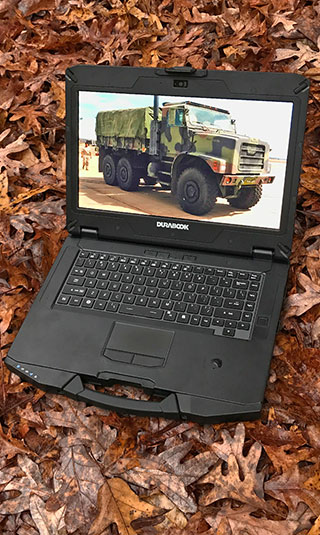 Historically, drop testing has been conducted in accordance with the procedures described in United States military standards. Drops are from a height of 48 inches onto 2-inch plywood over concrete. The machine is then dropped four to six times with the display closed and unit turned off. After each drop, the machine must be able to boot.
Historically, drop testing has been conducted in accordance with the procedures described in United States military standards. Drops are from a height of 48 inches onto 2-inch plywood over concrete. The machine is then dropped four to six times with the display closed and unit turned off. After each drop, the machine must be able to boot.
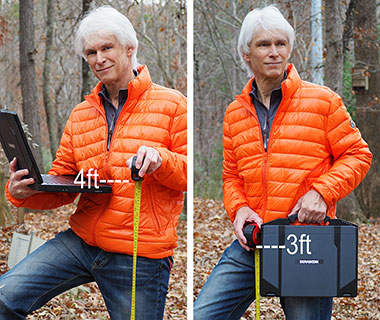 The relevance of the 4-foot drop versus the three feet limit of some of the competition is this: when you walk around with a notebook under your arm and you drop it, that's about three feet. But when you drop it while using it — which almost inevitably happens at some point — that's four feet. And the DURABOOK S14I can handle that.
The relevance of the 4-foot drop versus the three feet limit of some of the competition is this: when you walk around with a notebook under your arm and you drop it, that's about three feet. But when you drop it while using it — which almost inevitably happens at some point — that's four feet. And the DURABOOK S14I can handle that.
On the sealing front, Durabook Americas states IP53-level protection for the S14I. The "5" means protection against dust, with limited ingress permitted, and the "3" means protection against water spray spray up to 60 degrees from vertical. By comparison, when the S14I was introduced, the competition was still at IP51 and IP52 levels mean water dripping vertically (like condensation) and water dripping at angles up to 15 degrees, respectively.
Out there in nature water doesn't always harmlessly drip; there can be driving rain from an angle. And an IP53 machine like the DURABOOK I14S can handle that.
As for the operating temperature range, the S14I offers an impressive -4°F to 140°F (-20°C to 60°C), which means the laptop can be used virtually anywhere. The manual, however, still suggests "Use your notebook at the recommended temperature — between 32°F and 131°F — to ensure optimal performance." We've seen such discrepancies between specs and manuals before and wish they would go away.
It's clear that the DURABOOK S14I is a tough machine. It set new standards in the semi-rugged class. And for that reason we'd like to see more in terms of ruggedness testing information than just a brief "MIL-STD-810H certified (4' drop, shock, vibration, rain, dust, altitude, freeze/thaw, high/low temperature, humidity, temperature shock, humidity)" reference in Durabook literature. That ruggedness information should be detailed in the specs and also in a separate document.
Summary: The DURABOOK S14I
With the latest update, Durabook Americas' S14I semi-rugged laptop presents a thoroughly modern tool for customers who require class-leading high-performance computing power out there in the field, in vehicles, on the shop floor, or wherever else a tablet or a handheld just won't do. It's an attractive, businesslike machine with a very bright, reflection-free 14-inch wide-format display, good connectivity, good battery life, and superior performance.
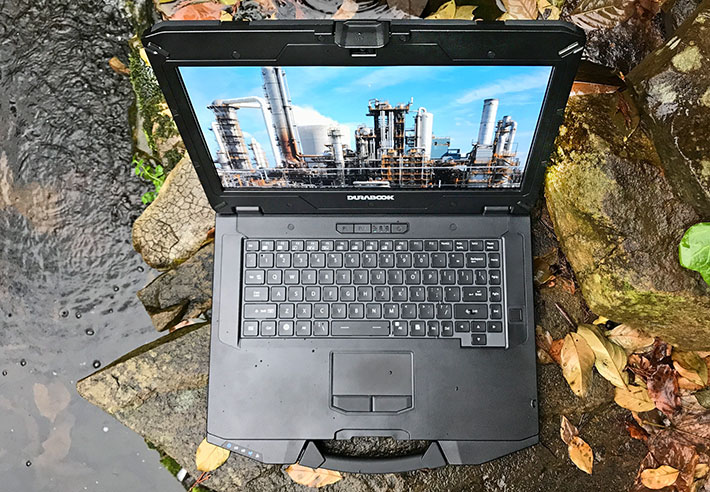
Note that compared to older semi-rugged DURABOOKS, the S14I is significantly thinner and lighter. Equally impressive are the laptop's 4-foot drop spec and its IP53 ingress protection rating, both exceeding old semi-rugged class standards.
The starting, bare-bones price of the DURABOOK S14I is very reasonable compared to fully and even most semi-rugged laptops. DURABOOKs are built-to-order and available with the usual wide range of configurations that can drive up the price.
DURABOOK laptops have always been strong performers, and never more so than with this latest version. Available with a choice of five quad-core Intel 11th generation Core processors, the laptop scored superior overall benchmark results. Battery capacity, though, is marginal and we recommend the optional secondary battery that doubles the capacity, albeit at the cost of other media bay options..
The DURABOOK S14I has a good FHD wide-format IPS display that controls reflection and glare well. Our review unit came with the optional sunlight-viewable 1000 nits (we measured 1145 nits) capacitive multi-touch screen.
Designed for demanding markets like public safety, government, military and field service, the DURABOOK S14I, with its magnesium alloy chassis and bottom, feels exceptionally solid and should hold up for a long time. However, even with IP53 sealing, it is not a fully waterproof design (open cooling vents to inside on side and bottom). Examine ruggedness specs to see if they match your requirements.
Overall, with the newly upgraded DURABOOK S14I, Durabook Americas has a very strong performer in the hotly contested market of semi-rugged laptops.
— Conrad H. Blickenstorfer, April 2021
 DURABOOK S14I Specifications DURABOOK S14I Specifications
|
| Status |
Added 10/2018, full review 8th-gen model 02/2019, full review 11th-gen model 04/2021
|
| Product type |
Semi-rugged notebook computer
|
| Processor |
Intel 11th Gen (Tiger Lake) Core i7-1185G7
Intel 11th Gen (Tiger Lake) Core i7-1165G7 (tested)
Intel 11th Gen (Tiger Lake) Core i5-1145G7
Intel 11th Gen (Tiger Lake) Core i5-1135G7
Intel 11th Gen (Tiger Lake) Core i3-1115G4
|
| CPU speed |
Core i7-1185G7: 3.0GHz (max Turbo Boost speed 4.8GHz), 12MB cache
Core i7-1165G7: 2.8GHz (max Turbo Boost speed 4.7GHz), 12MB cache
Core i5-1145G7: 2.6GHz (max Turbo Boost speed 4.4GHz), 8MB cache
Core i5-1135G7: 2.4GHz (max Turbo Boost speed 4.2GHz), 8MB cache
Core i3-1115G4: 3.0GHz (max Turbo Boost speed 4.1GHz), 6MB cache
|
| OS |
Windows 10 Professional
|
| Graphics |
i7 and i5 chips: Intel Iris Xe Graphics
i3: Intel UHD Graphics
Optional NVIDIA GeForce GTX 1050 MXM
|
| Memory |
8GB to 64GB DDR4 2400-3200MHz in two 204-pin SODIMM sockets |
| Display type |
Transmissive TFT with anti-glare coating and 10-step adjustable backlight OR
Optional 1,000-nits sunlight-readable without touch screen
Optional 1,000-nits (1145 nits as tested) sunlight-readable with touch screen (finger/water/glove/stylus selectable)
|
| Display size and resolution |
14.0"/1920 x 1080 pixel (157 ppi) FHD
|
| Digitizer/Pens |
10-finger capacitive multi-touch
|
| Keyboard |
Waterproof 86-key keyboard, optional LED backlight
|
| Storage |
256GB/512GB/1TB NVME PCIE SSD, optional OPAL 2.0 SSD, optional 2nd/3rd storage (SSD)
|
| Multimedia Pocket |
Super Multi DVD-RW Drive OR 2nd Battery Pack OR 2nd storage OR ExpressCard 54 slot OR PCMCIA Type II slot OR 2nd RJ45 and 2nd serial port
|
| Slots |
1 x SDXC Card, optional SmartCard reader
|
| Housing |
Magnesium alloy chassis |
| Temperature |
-4° to 140°F (-20° to +60°C)
est: |
| Humidity |
5 to 95% non-condensing |
| Vibration |
MIL-STD-810H tested
|
| Ingress protection |
IP53 |
| Explosive Atmosphere |
NA |
| EMI |
NA |
| Shock: Functional |
MIL-STD-810H tested
|
| Shock: Transit Drop |
MIL-STD-810H, Method 516.6, Procedure IV (26 4-foot drops to plywood over concrete) |
| Certifications |
FCC, DOC+ FCC ID, CE |
| Size (inches) |
13.8 x 11.1 x 1.5 inches (350 x 282 x 38 mm) including carry handle |
| Weight |
Starting at 5.1 lbs
|
| Power |
Hot-swappable 6-cell 10.8V, 4,700 mAH 50.8 watt-hour Li-Ion ("10 hrs."); optional second 6-cell 10.8V, 4.700 mAH battery ("10 hrs."), optional bridge battery (5 minutes swap time) |
| Camera |
Optional integrated 2-megapixel webcam with privacy shutter OR IR camera for Windows Hello
|
| Security |
Intel vPro (per CPU options), TPM 2.0, NIST BIOS compliant, easy removable SSD, stealth mode, Kensington lock; optional: smart card reader, Window Hello, night vision, fingerprint scanner, HF RFID/NFC reader
|
| Wireless |
Intel Wi-Fi 6 AX201 802.11a/b/g/n/ac/ax, Bluetooth 5.1; optional: dedicated uBlox NEO-M8N GPS, 4G LTE, RF antenna pass-through for GPS, WWAN, and WLAN
|
| Interface |
2 x Type-A USB 3.2 Gen 2, 1 x USB 2.0, 1 x Type-C USB 3.2, 1 x RJ45, 1 x DB9 RS232/RS422/RS485 serial, 1 x VGA, 1 x HDMI, audio in/out, dock, optional 1 x DB9 RS422/485 serial
|
| Price |
Starting MSRP: US$1,399 |
| Contact |
Durabook Americas
|
| Website |
Durabook S14I page |
| Brochure |
 Durabook S14I brochure Durabook S14I brochure |
| Warranty |
3-Year Standard Limited Warranty |
| Contact |
Durabook Americas, 48329 Fremont Blvd., Fremont, CA 94538, 510-492-0828 |
|






